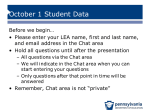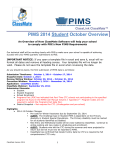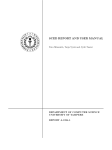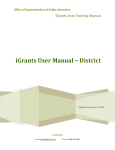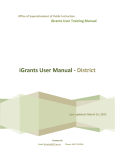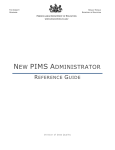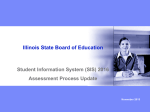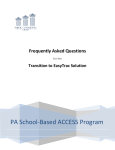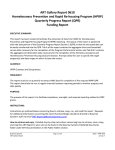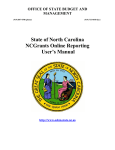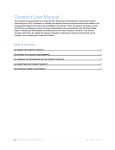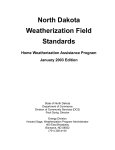Download • I would like to thank everyone for attending today`s webinar
Transcript
• I would like to thank everyone for attending today’s webinar presentation covering the PIMS June 16 ELL End of Year Student Count collection. • Today’s powerpoint presentation was emailed to participants. If you did not get the powerpoint presentation, it will be archived on the eslportalpa.info website within a day or two, along with the archived webinar. Today’s powerpoint will be posted with the note pages. So if you miss some of the items I go over today or want to reference an item discussed, they will be included in the note pages of the archived powerpoint presentation. 1 Our goal for today is that by the end of this training, you will have the knowledge and resources to accomplish the following: (read outcomes). 2 • • In order to reduce duplication and lesson the burden on LEAs, PDE transferred data elements previously collected in the LEP System to PIMS for the 2013‐2014 school year. So for the June 16 ELL End of Year PIMS collection, reporting LEAs with ELLS enrolled are required to complete the Programs Fact Template and submit it, along with the other required templates. New data elements added to the Programs Fact Template include: • Program Codes – 039‐046 ‐ These codes indicate the instructional model used by the ESL or Bilingual teacher to provide the students direct core ESL instruction. You can understand it these codes by thinking of it this way: If a student is ELL, they must participate in an ESL or Bilingual Program. If the student is in an ESL or Bilingual Program, they must be receiving direct instruction through a research‐based delivery model. These codes reflect that delivery model. A student should only have one program selected within the range of program codes 039‐046 which reflects the instructional model used by the ESL or bilingual teacher to provide explicit English language development instruction. • Additional program codes (Program Codes – 047‐054) are used only 3 • • if the LEA receives Title III dollars and the LEA uses these monies to provide instruction that supplements—is in addition to‐‐their daily direct core ESL instruction. Title III subgrantees need to determine if Title III dollars are designated for supplemental instructional services for ELLs, and if so must indicate which delivery model within the range of program codes 047‐054 is used to deliver that supplemental LEP instruction. Not all LEAs use their Title III dollars for supplemental instructional purposes, so if you are a Title III subgrantee, you should find out from your Federal Programs and/or ESL Coordinator how your Title III funding is allocated. It is imperative that the PIMS Administrator/Coordinator work with an ESL Coordinator/teacher at your LEA to code the delivery models collected in the Programs Fact Template. 3 Also, new for the June 16 ELL End of Year PIMS collection is the collection of data elements in the district fact template. These data elements also were previously collected in the LEP System but are now being collected in PIMS during the ELL End of Year Student Count collection. SDs, CSs, and Comprehensive CTCs only are required to complete the District Fact Template for LEP and submit these data elements with the other required templates during this PIMS collection. 4 • The window for this collection runs from June 16 – July 11, 2014. • Please note that due to the PIMS Maintenance and Cognos downtime scheduled for the week of June 23 (which is taking place earlier this year), we have extended our collection window which was originally scheduled to end June 30 to July 11. • Each PIMS collection has a “snapshot date” that is selected for logistical purposes, to allow the collected data to remain static and unchanged once this collection is closed. The Snapshot date for this PIMS collection is June 16, 2014. • This collection is not a true snapshot. We are not collecting students relative to their status on June 16. Instead, we are collecting a total, cumulative record for the 2013‐14 school year. • The ACS for this collection is due September 8, 2014. 5 The purpose for this PIMS collection is to collect data required for federal reporting to the U.S. Department of Education and to capture evidence of LEAs implementation of ESL policy for compliance monitoring. Specifically, we report to the US Department of Education: 1. The number of ELLs enrolled in an elementary and/or secondary school at any time during the 2013‐2014 school year by grade level. 2. The number of ELLs enrolled in an elementary and/or secondary school at any time during the 2013‐2014 school year by home language. 3. The number of ELLs enrolled in an elementary and/or secondary school served by an English language instruction educational program supported with Title III funds at any time during the 2013‐2014 school year by grade level. 4. The number of students who meet the Title III definition of immigrant children and youth in ESEA Title III, Section 3301(6) and are enrolled in elementary and secondary schools during the 2013‐2014 school year by LEP status (meaning we are indicating which students are limited English proficient and which students are not limited English proficient students). 5. The number of students who meet the Title III definition of immigrant children and youth in ESEA Title III, Section 3301(6) and are enrolled in elementary and secondary schools during the 2013‐2014 school year by home language. 6 Language codes for languages used in bilingual language instruction 6 7 • For the PIMS June 16 ELL End of Year Student Count collection, the following entities are required to submit data: • (Listed above). These are the same entities required to provide enrollment counts during the October PIMS Collection. So, in March we reported to the United States Department of Education ELL students being educated by your LEA on October 1 and now we are collecting and will be reporting to USDE the number of ELL students enrolled in an elementary and/or secondary school at any time during the 2013‐2014 school year, cumulative totals for your LEAs. • If you are an entity who is required to submit data to the June 16 collection and your LEA did not enroll any English language learners at any time throughout school year 2013‐14, you must still upload your student template and student snapshot template. This is necessary because PDE is required to report to USDE data on all LEAs, including those with a zero count. 8 • Keep in mind that each PIMS data collection is used for a different purpose and the criteria for the students included is different for each student snapshot. • Our focus today is the June 16 ELL End of Year Student Count Collection. • Five templates are required to be uploaded during the June 16 ELL End of Year Student Count Snapshot: • • • • • Student Template Student Snapshot Template School Enrollment Template Program Facts Template District Fact Template (for SDs, CSs, and Comprehensive CTCs only) • Any student record in a student snapshot template must be in the student template to successfully upload the student snapshot template. 9 10 Remember that not all rules apply to other PIMS collections. Some rules are unique to certain PIMS collections. There are some additional challenging reporting scenrios we’d like to address: In the case of cyber program students: Cyber programs are treated like extensions of the sending school(s) for the June 16 ELL End of Year collection. Students are reported in the schools that sent them to the cyber programs. Exception: A school district created a new school (has a school number) that is their cyber school in accordance with School Services Guidelines. 11 • In the case of alternative education students who are district‐placed and should be reported in the school in which they would be educated if not placed in the program… • New Codes were added to the Programs Fact Template in SY 13/14 to identify AEDY students. These Program Codes are 035‐038, and they can help you identify LEP students who are AEDY students. • Program Code descriptions: AEDY – School District – Report if student is in a district operated AEDY Program regardless of program location. AEDY – Intermediate Unit – Report if student is in an intermediate unit operated AEDY Program regardless of program location. AEDY – CTC – Report if student is in a CTC operated AEDY Program regardless of program location. AEDY – Private – Report if student is in an AEDY private provider operated AEDY program regardless of program 12 location. 12 In the case of alternative education students who are not district‐placed but are outside –placed… These entities do not have school codes and cannot report to PIMS, so it remains the district responsibility to report these students to PIMS with school location codes of 9999 for these students. 13 • The following slides discuss the definitions, business rules, and valid values for specific data fields in the PIMS student snapshot template, programs fact template, and district fact template that are used by the ESL Program area for federal reporting purposes, compliance monitoring and for data analysis. • Please note that we are not reviewing all of the required fields contained in the student template and student snapshot template, only those data elements that directly affect our federal reporting, compliance monitoring and data analysis. LEAs, however, do need to include all required data elements contained in the student snapshot template during the June 16 PIMS collection even if it is an item not specifically mentioned during this webinar. 14 • The format for the following slides is as follows: • The left hand side of the screen indicates the PIMS definitions, business rules and valid values required for certain fields contained in the student template and student snapshot template, programs fact template, and district fact template. • The right hand side of the screen provides the data elements and values the ESL Program area pulls for federal reporting, data analysis, and compliance monitoring purposes. 15 • The PAsecureID is essential for federal reporting purposes, compliance monitoring and data analysis . PaSecure ID is the key data element that links all data together and allows PDE to track students longitudinally. • The PAsecureID must be a 10 digit unique number that is assigned to a student. Any PasecureID that does not pass the check digit validation rules is invalidated and, therefore, these students are not included for accountability and federal reporting purposes. Here are some HELPFUL HINTS to keep in mind about PASecureIDs: • Unique ID assigned to student…Single ID follows student through grades & LEAs (PK – Postsecondary) • NEVER create a new ID unless student is new to PA public school system • Ask for PAsecureID on confidential transcripts for transfer students • Don’t assume K students do not have a PAsecureID. If a student attends a public Pre‐K program the student could already have a PAsecureID. 16 •This slide provides the link to webinars, memos, announcements, how‐ to guides and training documents covering PAsecureID. If you have additional questions or need more guidance, please use this link to access these resources. •For additional assistance, contact PAsecureID HELP desk at 1‐800‐661‐ 2423 17 • LEP/ELL Status is a key data element for the PIMS June 16 ELL End of Year Data Collection. LEP/ELL Status is located in Field #41 and is a PIMS required field. • The PIMS valid values for reporting your LEP/ELL students are as follows: •01 Current ELL. That is any student enrolled in your LEA and receiving instruction in your LEA’s ESL or Bilingual Educational Program during the 2013‐2014 school year. •03 Former ELL, exited, and in first year of monitoring. This is any student who was exited from your LEAs ESL/Bilingual Program and was monitored during the 2013‐ 2014 school year. Students in the first year of monitoring have met the State’s required exit criteria for Pennsylvania’s English Language Instructional Programs for English Language Learners, were exited by October 1, 2013 and did not receive instruction in an ESL and/or Bilingual Educational Program during the 2013‐2014 school year. •04 Former ELL, exited, and in second year of monitoring. That is any student who was exited from your LEA’s ESL/Bilingual Program and monitored for 1 year during the 2012‐2013 school year and continued to be monitored for a 2nd year during the 2013‐ 2014 school year. LEAs should include in this category students who have been monitored for academic achievement and progress for the second year during the 2013‐2014 school year as required by NCLB. This is any student 18 •05 Former ELL, exited and no longer monitored. This is any student who met the State’s exit criteria, exited the program, and met the 1st and 2nd year monitoring provisions prior to the 2013‐2014 school year. •REMINDER: When a student’s status changes from 01 (current ELL) to 03 (Former ELL, exited, and in first year of monitoring), the Program Facts Template should be updated by ending the ESL program code designation (Field 5, Code 031). If the student was served by Title III supplemental funding, the Program Facts Template should be updated by ending this program code (Field 5, code 019). •99 Never ELL. That is any student who, based on the Home Language Survey and multiple criteria, was not eligible for English language development instruction. • PDE also uses field 41 of the student snapshot template, valid values “03” and “04” to report to the federal government the number of students who were formerly Title III limited English proficient students, referred to as monitored former LEP students. • If your LEA does not properly code students, the student will not be included for federal and state reporting purposes and for data analysis. • It is imperative that the PIMS Coordinator work with an ESL Coordinator/Teacher to ensure that all students at your LEA are properly coded as ELL, first year monitoring, and second year monitoring prior to uploading to the PIMS June 16 ELL End of Year Student Count collection. 18 •If a student is identified as an ELL in field 41 of the Student Snapshot Template with a valid value of 01, current ELL, then there are additional codes which must be entered in the programs fact template. That is, there are codes that come into play once a student is identified as 01 in the student template. Valid value 01 and these additional codes are co‐ dependent. •The first additionally required code that must be included in the Programs Fact Template field 5 is code 031. This code indicates participation in an ESL or Bilingual Program. If the student is ELL, the student must be in an ESL or Bilingual program, and this code reflects that. •So, when you are validating your data, keep in mind that the number of current ELLs reported (field 41, value 01 Student Snapshot Template) and number of ELLs participating in an ESL or Bilingual Program (field 5, value 031 Programs Fact Template) should be consistent. You can’t have one without the other. 19 Additional codes were added to the Programs Fact Template, field 5, that provide the instructional delivery model of core instruction the student is receiving (Codes 039‐046). These codes indicate the instructional model used by the ESL or Bilingual teacher to provide their daily direct core ESL instruction. If a student is ELL, they must participate in an ESL or Bilingual Program. If the student is in an ESL or Bilingual Program, they must be receiving direct instruction through a research‐based delivery model. These codes reflect that delivery model. A student should only have one program selected within the range of program codes 039‐046. So, when you are validating your data, keep in mind that all current English language learners (Field 41 of the Student Snapshot template), reported as a valid value “01” must also be reported in Field 5 with a Program Code of 031. In addition, LEAs must provide in field 5 the model of delivery used by the ESL or Bilingual education teacher to provide the direct core ESL instruction, selecting a Program Code within the range of 039‐046. You can’t 20 have one without the other two. 20 If a student is a current ELL (01 in field 41 in student template and student snapshot template) that 01 automatically requires the inclusion of other data elements. This relationship is depicted on the slide. 21 • LEP/ELL Eligibility, (Field 95) captures which ELL students are Title III served. This static Title III indicator captures the Title III status of students in the student snapshot template for federal reporting purposes. • To determine who to count as Title III served, you need to first find out if your LEA accepts Title III dollars. If the LEA is a Title III served entity either as a single subgrantee or as a consortium member, the LEA must report all current ELLs (looking at Field 41, valid value 01) as Title III served with a valid value of YES in Field 95. If your LEA does not receive Title III dollars, or does not accept Title III allocations, then Title III eligibility is reported as NO in field 95 of the student template. • Keep in mind, that in order to be Title III served, that is a YES in Field 95, the student must also be an 01 in Field 041. Field 95 only comes into play if field 41 is 01. You can have an 01 in Field 41 and NO in Field 95, but you cannot have a YES in Field 95 without an 01 in Field 41. This relationship is represented in the right hand side of the slide. 22 •If a student is identified in field 95 of the Student Snapshot Template with a valid value of YES, Title III served, then there is an additional code which must be entered in the programs fact template. That is, there is a code that comes into play once a student is identified as Title III served in the student template. •The additionally required code that must be included in the Programs Fact Template field 5 is code 019. This code indicates participation in an ESL or Bilingual Program supported with Title III funds. If the student is Title III served, the student must be in an ESL or Bilingual program that is benefitting from Title III funds, and this code reflects that. •So, when you are validating your data, keep in mind that if you are a Title III served entity, either as a single subgrantee or as a member of a consortium, the number of current ELLs reported (field 41, value 01 Student Snapshot Template), the number of ELLs participating in an ESL or Bilingual Program (field 5, value 031 Programs Fact Template), the number of Title III served ELLs (YES in field 95 of student snapshot template) and number of ELLs participating in a Title III served ESL or Bilingual Program (coed 019 in field 5 programs fact template) should be consistent. You can’t 23 have one without the other. • Additionally, the Title III indicator is important for accurate reporting of 1st and 2nd year monitored students, so we want to emphasize how important it is to keep your SIS up‐to‐date for data accuracy. It is important to remember that when a Title III student exits the ESL program and their status is changed to 1st year monitoring in Field 41 of the student template and student snapshot template, the student is no longer eligible to participate in the LEAs Title III program. Therefore, the Title III indicator “019” in the Programs Fact Template Field 5 must be ended. 23 ESL or Bilingual Program (Title III Supplemental LEP) is one of the new data elements being collected this year in PIMS. This data element is collected in the PIMS Programs Fact Template in Field 5. As I stated earlier, these Program Codes – (047‐054) ‐ are used only if the LEA receives Title III dollars and the LEA uses these monies to provide supplemental instruction. LEAs need to determine if Title III dollars are designated for LEP supplemental instructional purposes and if so must indicate which delivery model within the range of program codes 047‐054 the student is receiving in the supplemental LEP instruction course. Not all LEAs use their Title III dollars to supplement their direct core ESL instruction, so if you are a Title III LEA you should find out from your Federal Programs and/or ESL Coordinator how your Title III funding is allocated. 24 If a student is a current ELL (01 in field 41 in student template and student snapshot template) in an LEA that accepts Title III funds as a single subgrantee or as a member of a consortium, that also automatically requires the inclusion of other data elements. This relationship is depicted on the slide. To begin, the current ELL must be indicated as Title III served with a YES in field 95 of the student template and student snapshot template. And then, the YES automatically requires the inclusion of other data elements, as illustrated here. 25 Years in U.S. Schools is collected in Field 125. This is a PIMS conditionally required field. Here we are looking for an integer value (1, 2 or 3) that indicates the years that a student meets the Title III immigrant definition for federal funding purposes. According to Title III, and immigrant child… • Is age 3‐21 • Was not born in any state; and • Has not been attending one or more schools in any one or more States for more than 3 full academic years. To report eligible Title III immigrant students, follow the business rules in the PIMS Manual Volume 1. (See criteria above) In the case of re‐entry into U.S. Schools, the calculation for years in US schools is cumulative. It does not start over. Use best information available. 26 • Here are additional data elements collected. This is not a complete list of all of the required data elements collected in the templates required for the June 16 PIMS Collection, but these are some of the key data elements used for federal reporting purposes. • Native Language has a DQE data check applied to it. So if you report a student as a valid value of 01 in Field 41 ELL/LEP Status, the LEA must report the native language a child is/was exposed to that resulted in identification as an English language learner. 27 The additional data elements required to be submitted include: • Chapter 4.26 core program requirements. Every LEA is required to provide a program for each student whose dominate language is not English for the purpose of facilitating the student’s achievement of English Proficiency and the academic standards. Every LEA must have a written Board approved ESL Program which describes in sufficient detail how the LEA will ensure that ELLs increase English proficiency, attain English proficiency and meet academic standards while they’re progressing toward attainment of English proficiency. LEAs who do not have any ELLs at this time will need to refer to the LEAs Board approved ESL policy to respond to the questions. The valid values are a Y or N…meaning Yes, the LEA includes the element in its board‐approved policy and maintains documentation of its implementation he requirement, or No, the LEA does not include the requirement in its Board approved ESL Program and does not maintain documentation of its implementation. 28 • Assessments used upon entry, ongoing, and for exit. Here we are looking for the assessments the LEA administers to ELLs upon entry, ongoing, and at the time of exit. More than one assessment can be chosen for each category listed. So for example, the W‐APT is required for placement of ELLs, so it must be included as an assessment used upon entry. If the LEA uses an assessment that does not appear within Category 3, email the name of the assessment the LEA is using to ra‐[email protected]. • Bilingual Program Models – language code(s) for the language of instruction. If the LEA implements any of the Bilingual Program model(s) indicated: dual, two‐way, transitional, developmental, or heritage, the LEA must provide the language code from Appendix J, PIMS User Manual Volume 2, for the language(s) of instruction, other than English. • Teacher Counts – Here we are asking LEAs to provide a count of the total number of all certified licensed teachers currently working in a language instruction education program (core ESL program and, if applicable, supplemental Title III program) and the total number of all teachers not fully certified currently working in a language instruction education program (core ESL program and, if applicable, supplemental Title III program). To determine what teachers to count as working within your language instruction educational program (core, and if applicable, Title III) you need to refer to the type(s) of instruction you indicated in the Programs Fact Template (Program Codes ‐039‐054). For Example, if you are an LEA who is doing Core Program – pull out (ESL), your counts are based on that. If you are an LEA who is doing Core Program‐sheltered instruction and Title III Supplemental LEP – Pull‐Out (ESL) your counts are based on that. If you are doing more than one instructional type, your counts are based on the total for all types of instruction. Report how many teachers are fully certified and how many are not fully certified. • We also need LEAs to provide the estimated total number of 28 additional certified/licensed teachers that will be needed for language instruction educational programs for the next five years (core ESL program and, if applicable, supplemental LEP‐Title III)…reporting only the total additional teachers needed over the next five years, not the number needed for each year. For the total number of additional teachers count, do not include those teachers you currently have hired for your ESL program and/or Title III program; this question is only asking for additional teachers needed. • Lastly, ESL budget – Here we are asking LEAs to provide the dollar amount allocated to the LEA’s general budget for English language instruction programs. It is imperative that the PIMS Administrator/Coordinator work with an ESL Coordinator/teacher at your LEA to respond to the LEP categories collected in the District Fact Template. 28 • We are developing a template (like the Patti Survey) for next year that LEAs will be able to access and use to create their District Fact Template for next year’s ELL End of Year PIMS collection. 29 • This screen provides PIMS Cognos Validation Reports available to LEAs to verify the data uploaded to the PIMS June 16 ELL End of Year Student Count collection. • On the left side of the screen are reports you can access in Cognos through Production. The path is provided for your ready reference and the types of reports available are listed on the screen. • On the right side of the screen are the reports you can access through Verify. Again the path is provided and the types of reports you can pull are listed on the screen. • When pulling the Program Fact Template Details report, all of the programs are listed alphabetically. You can pull all and then filter in excel by program, or you can just select the program you want to verify. So for the PIMS June 16 ELL End of Year Student Count collection, you could just pull those students that are participating in your Title III (Supplemental LEP) program using the Program Fact Template Details report. Same applies to students that are participating in your ESL or Bilingual Education Program (Core). When pulling the Student Snapshot Template Detail report, we want to 30 caution you that it is not in the same format of the template you upload into PIMS so you want to make sure when verifying data that you are looking in the appropriate column. 30 • Be sure that all data is accurate before submitting the ACS. Pull PIMS validation reports discussed on the previous slide to verify accuracy. • ACS is being updated and will be available after PIMS upgrade is concluded (July). • If you submit your ACS and then realize you need to change your data in the PIMS June 16 ELL End of Year collection, you need to submit an updated signed ACS. • As soon as you upload your ELL End of Year Student Count snapshot, it is important to pull your ACS to ensure it is accurate. Early submission of your ACS allows PDE Staff time to review and verify your data for accuracy. Waiting until the end of the collection window might have implications on being able to correct data elements while the snapshot is open for corrections or deletion requests. • Make sure the data contact information contained on the ACS is clear 31 and includes a phone number and email contact information in case we need to contact your LEA for clarification purposes. • If you submit your signed ACS via fax or eMail, you do not need to mail the signed original copy to PDE. 31 32 33 34












































